Curriculum
Paid Advertising on Social
Meta / Facebook & Instagram
0/6Creating Audiences
Create a NEW Facebook Ads Audience
In Facebook there are three types of Audience:
- Custom Audiences – allows you to advertise to existing audiences. You can create an audience from your customer contact lists, website traffic visitors to your Facebook or Instagram page or profile.
- Lookalike Audiences – Reach new audiences who are likely to be interested in your business because they share similar characteristics to your existing customers. A Lookalike Audience uses an existing custom audience that you select for its source and create an audience that looks like that custom audience within a percentage similarities.
- Saved audience – this is the one you will use the most. It is saved and based on your commonly used targeting options for easy reuse such as location, demographics, interests and behaviours. Once saved you can use them in future ads
Define your target audience and SAVE IT
Think about characteristics that your current customers have in common, such as demographics, location and interests. Then, broaden or narrow that audience based on your population size.
Name it so you know who you are targeting i.e. location – age – interest i.e. “Macquarie 35+ Married then build and refine your audience.
1. Create an audience
As you create your target online audience, keep an eye on the audience meter, which will let you know whether your audience is too specific, too broad or just right.
2. Start broad
Facebooks ad delivery system works best when your audience size is between 2 to 10 million people. With a bigger audience, the auction will have greater opportunities to deliver ads, observe outcomes and optimise. Consider the location, age and gender of the customers that you want to see your ads.
3. Add more details
Using detailed targeting such as adding ‘interest’ targeting may lead to smaller audiences, but it may also help better target your ads to an audience more likely to respond to your ads. We recommend using interest targeting only if your audience is at least 2 million people.
New customers with specific interests or from a specific location.
This is the default selection for your ad set in Ads Manager. Attract new customers by refining your new audience with categories such as location, demographics, interests and behaviours.
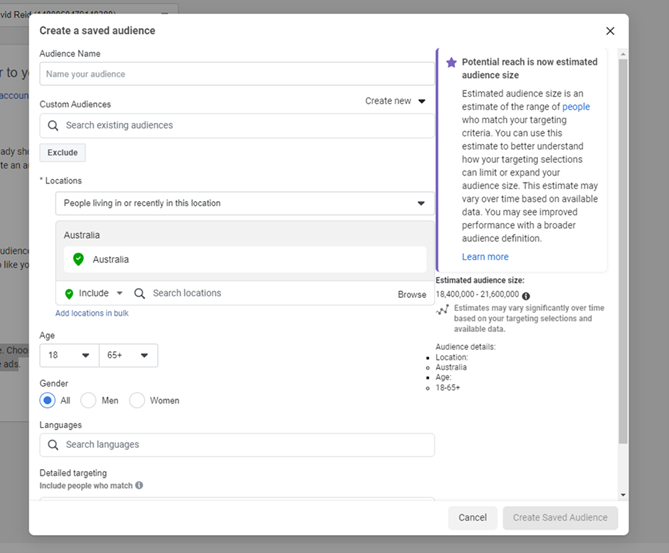
What is a Facebook Custom Audience?
Facebook Custom Audiences are highly defined groups of people who already have a relationship with your business. These groups likely include past customers and people who have visited your website or installed your app.
Even better, Customer Audiences can create lookalike audiences – new potential fans, followers, and customers who share key characteristics of your existing audience.
Basically, it offers some of the best ad targeting available.
But not everyone is a fan of data sharing. Some argue it’s an invasion of data privacy.
That’s why Apple changed its policy with the iOS 14.5 update to turn off the Identifier for Advertisers (IDFA) by default.
The IDFA tracked user behaviour within apps – making it easier to create highly-targeted ads.
With the new Apple update, users are prompted to opt-in or opt-out of data sharing for each app they use.
So far only 25% of users have opted in to data sharing. Without the default IDFA setting, advertisers and app developers are drastically limited in tracking user activity.
How does it affect Facebook Custom Audiences?
You may notice results decrease, and you may want to consider alternative strategies if that’s the case for you.
Facebook recommends using a broad audience or targeting expansion to meet your campaign goals. You can also find more detailed guidance here.
Regardless, Facebook Custom Audiences can still help you reach your ideal customers, and there are plenty of ways to connect with them.
Types of Custom Audiences
There are actually several ways to build a Custom Audience. Let’s review the types and sources for creating a Facebook Custom Audience.
1. Custom Audiences from customer lists
Customer lists are an audience who have already shown an interest in your business or product. But the source doesn’t come from Facebook engagement or Meta Pixel.
Instead, you tell Facebook “identifiers” you’ve collected from your audience. Examples include the email address of a newsletter subscriber or past customers who have shared their phone numbers with you.
These are people who have engaged with your business in some way, but Facebook has no way to identify them until you upload a customer list.
Keep in mind that there are a lot of data privacy rules around customer lists. Here are some aspects to consider:
- You can only upload data from customers who have consented to their information being used for marketing purposes
- You can’t use a purchased customer list or data you’ve gathered from other websites
- If someone opts out of your email list, you need to remove them from your Custom Audience too
- Check Facebook’s Terms of Service to ensure compliance
2. Custom Audiences from your website
Once you install the Meta Pixel on your website, it can match your website visitors to their Facebook profiles.
You can use this information to create Custom Audiences that target:
- All website visitors
- People who have visited a specific product page or product category.
- Recent website visitors by choosing a timeframe for how far back you want to go
If you haven’t installed the Meta Pixel yet, you’re missing out on this rich source of data.
3. Engagement Custom Audiences
An Engagement Custom Audience is made up of people who have interacted with your content across Meta technologies like Facebook or Instagram.
These people have done specific actions like:
- Viewed a video
- Engage with your profiles and content
- Clicked on an ad
- Responded to an event as “Interested”
While Facebook keeps track of these actions, you can also create a setting to refresh the audience, say, every 30 days.
This means only people who have engaged with your content in the past 30 days will be part of your Engagement Custom Audience. It helps ensure you’re still relevant to the people viewing your ads.
How to create custom audiences in Facebook
For all Custom Audience types, you’ll start by opening your Facebook audiences page in Ads Manager and clicking “Create a Custom Audience”.
(If you’ve created an ad before, you’ll see a dropdown menu instead of a button.)
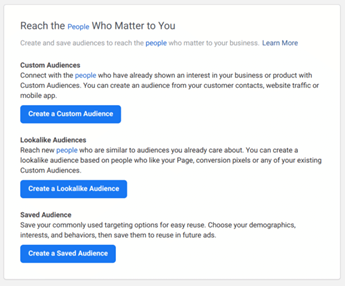
From here, the process depends on what kind of Custom Audience you want to create.
How to create a Facebook custom audience from a customer list
1. Prepare a customer list in advance.
You provide Facebook the information on your customers, so you’ll need to create a CSV or TXT file of “identifiers” (such as an email address) to help it match your information to Facebook profiles.
Luckily, Facebook has a guide on how to format your customer list to get the best matches.
2. Choose a Custom Audience Source.
You’ll be presented with a variety of options on where the source of your information comes from.
Select “Customer list” and move on to the next step.
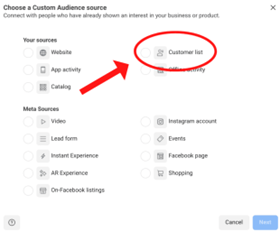
3. Import customer list.
If you prepared a CSV or TXT file, then you can upload it here.
You’ll also name your Custom Audience at this point. If you’re using MailChimp, you have the option to import it directly from there.
4. Review your customer list.
Facebook will let you know if there are any errors on your list. This gives you a second chance to ensure your list is correctly mapped.
Once you’ve reviewed your list, you can tap “Upload & Create”.
Facebook will let you know when your Custom Audience is ready to use for ad campaigns or to create lookalike audiences.
How to create a Facebook custom audience from website visitors
1. Install Meta Pixel or ensure it’s active.
Your website visitors can only turn into a Custom Audience if Meta Pixel is installed on your website.
If you need help, check out Facebooks guide on using Meta Pixel on your website.
2. Choose a Custom Audience Source.
You’ll be presented with a variety of options on where the source of your information comes from.
Select “Website” and move on to the next step.
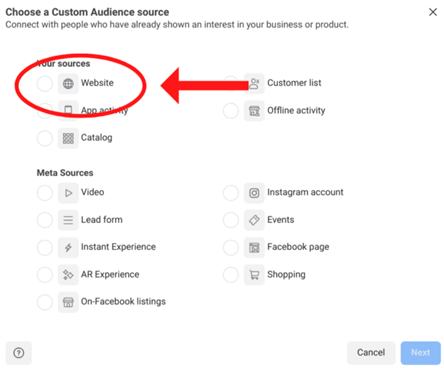
3. Set rules.
This is the fun part. You’ll choose the source, events, retention period, and inclusive/exclusive rules.
Some of the rules you can create or select include:
- Target all website visitors
- Target people who visited specific pages or websites
- Target visitors based on time spent on your website
- Timeframe of how long people will stay in the custom audience after their last website visit
- Include a different set of visitors
- Exclude a specific set of visitors
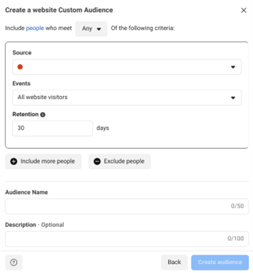
4. Name and describe the Custom Audience.
To make it easier to track all of the Custom Audiences you’re making, give clear names to each one.
You can write a quick description for further clarification if needed.
5. Select “Create audience”.
Ta-Da! Facebook will prepare your Custom Audience based on your website traffic and designated rules.
Use lookalike audiences
Custom Audiences are used to make lookalike audiences – a group of people who share similar characteristics to your Custom Audience.
In theory, a lookalike audience is more likely to be interested in the products and services you offer compared to a broad audience.
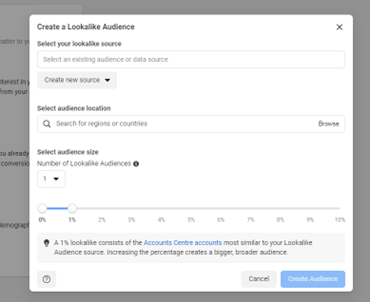
Next Lesson: Ads Manager vs Boosted Posts